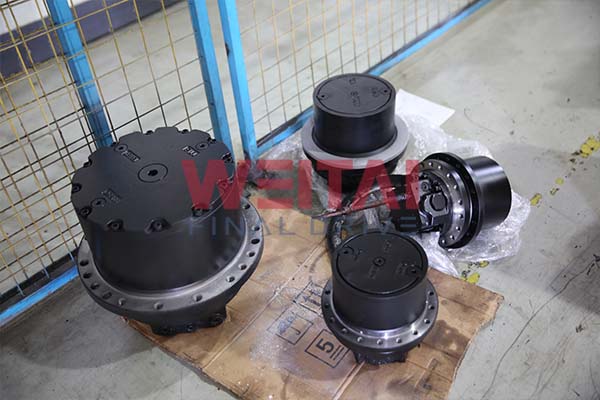Choosing the right final drive motor for your machinery is crucial to maximizing performance, efficiency, and longevity. The two primary types of final drive motors—hydraulic and electric—each have their own strengths and applications. Understanding the differences between these two motor types can help you make an informed decision for your heavy equipment, whether it’s an excavator, bulldozer, or tracked loader.

In this blog post, we’ll compare hydraulic and electric final drive motors, examining their advantages, disadvantages, and ideal use cases to help you decide which option is better for your machinery.
______________________________________
Hydraulic Final Drive Motor
A hydraulic final drive motor delivers the necessary torque and power to move the tracks or wheels of heavy machinery. It’s the component responsible for converting energy (hydraulic or electric) into mechanical motion, allowing the machine to move forward or backward. Whether you’re operating in construction, mining, or agriculture, the right hydraulic final drive motor is critical for reliable performance. Now, let’s break down the two main types:
Hydraulic Final Drive Motor: Strength in Power
Hydraulic final drive motors are powered by hydraulic fluid, using pressure and flow to create motion. These motors are most commonly used in heavy equipment like excavators, bulldozers, and skid steers.
Advantages of Hydraulic Final Drive Motor
1. High Power Density: Hydraulic motors deliver immense power relative to their size, making them ideal for heavy-duty applications. This high power-to-weight ratio allows them to generate the massive torque needed for large machinery.
2. Durability in Tough Conditions: Hydraulic systems can endure extreme environmental conditions such as heat, dust, and dirt. Their robust design and materials make them reliable even in harsh terrains and heavy workloads.
3. Simplicity and Proven Reliability: Hydraulic final drives have been in use for decades, and their simple mechanical design translates into fewer moving parts, reducing the chances of failure. This means less frequent maintenance and longer operational life.
4. Smooth Operation: These motors provide precise control over movement, making them excellent for machines that require fine handling, like excavators or forestry equipment.
Disadvantages of Hydraulic Final Drive Motors
1. Maintenance Intensive: While durable, hydraulic systems require regular maintenance, including checking for leaks, changing filters, and monitoring hydraulic fluid levels.
2. Lower Efficiency: Hydraulic motors are less efficient than electric motors because some energy is lost as heat during fluid movement. This can lead to lower fuel efficiency in machinery.
________________________________________
Electric Final Drive Motors
Electric final drive motors use electric power to generate motion, converting electrical energy into mechanical movement. They are gaining popularity in smaller construction equipment, as well as in applications where emissions reduction is a priority.
Advantages of Electric Final Drive Motors
1. Energy Efficiency: Electric motors are typically more efficient than their hydraulic counterparts. They convert a higher percentage of electrical energy into mechanical motion, meaning less energy waste and lower operating costs.
2. Low Maintenance: Electric motors require less maintenance since they don’t have fluid to manage or as many moving parts to wear out. This makes them an appealing choice for equipment owners looking to reduce downtime and maintenance costs.
3. Quieter Operation: Electric final drive motors run much more quietly than hydraulic systems. This is a significant advantage in urban construction projects where noise regulations are strict, or for operators looking for a more comfortable work environment.
4. Environmental Benefits: Electric motors are emission-free and can be powered by renewable energy sources, making them an excellent choice for companies focused on sustainability and reducing their carbon footprint.
Disadvantages of Electric final drive motors
1. Power Limitations: Electric motors struggle to match the raw power output of hydraulic motors. They are typically more suitable for smaller equipment and are not yet viable for the largest and heaviest machinery.
2. Battery Dependency: Electric motors require batteries, which can limit the operational time between charges. This is a challenge for heavy equipment that operates continuously throughout the day in remote areas without easy access to charging infrastructure.
3. Higher Upfront Costs: While electric motors may save on maintenance and operational costs, they generally come with higher upfront costs due to the expense of batteries and sophisticated electrical systems.
________________________________________
Which Motor is Right for Your Machinery?
The choice between hydraulic and electric final drive motors depends largely on your machinery’s specific needs, application environment, and long-term goals. Below are some considerations to help guide your decision:
When to Choose a Hydraulic Final Drive Motor?
• Heavy-Duty Applications: If you operate large machines like excavators, bulldozers, or mining equipment, the sheer power and torque of hydraulic motors make them the better choice.
• Harsh Operating Environments: For machinery working in tough, dusty, or wet conditions, hydraulic motors’ ruggedness and durability make them more reliable.
• Smooth Movement Control: Hydraulic motors are ideal for applications requiring precision control, such as lifting or rotating heavy loads in construction.
When to Choose an Electric Final Drive Motor?
• Smaller, Lightweight Equipment: For compact machinery such as skid steers, forklifts, or small loaders, electric motors offer sufficient power and greater energy efficiency.
• Environmentally Focused Operations: If sustainability and emission reduction are high priorities for your operation, electric motors provide a greener alternative.
• Reduced Maintenance Costs: If you’re looking to minimize maintenance and want quieter, simpler operation, electric motors will likely offer better long-term value.
________________________________________
Conclusion: Finding the Right Balance
Both electric and hydraulic final drive motors have their strengths and weaknesses, and the best choice for your machinery ultimately depends on the nature of your work. If you need power, durability, and reliability, hydraulic motors are the clear winner. However, for smaller, lighter equipment or operations prioritizing efficiency and sustainability, electric motors provide an excellent alternative.
As technology evolves, we may see electric motors becoming more powerful and applicable to a wider range of heavy machinery. Until then, understanding your specific needs and working conditions will help you choose the final drive motor that will keep your machines operating at peak performance.
Post time: Sep-06-2024
